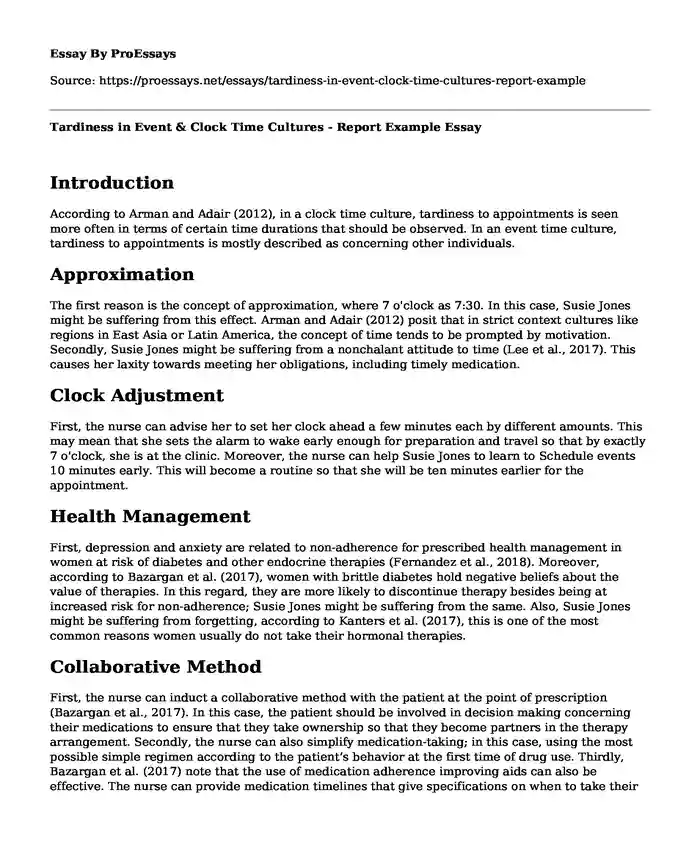Introduction
According to Arman and Adair (2012), in a clock time culture, tardiness to appointments is seen more often in terms of certain time durations that should be observed. In an event time culture, tardiness to appointments is mostly described as concerning other individuals.
Approximation
The first reason is the concept of approximation, where 7 o'clock as 7:30. In this case, Susie Jones might be suffering from this effect. Arman and Adair (2012) posit that in strict context cultures like regions in East Asia or Latin America, the concept of time tends to be prompted by motivation. Secondly, Susie Jones might be suffering from a nonchalant attitude to time (Lee et al., 2017). This causes her laxity towards meeting her obligations, including timely medication.
Clock Adjustment
First, the nurse can advise her to set her clock ahead a few minutes each by different amounts. This may mean that she sets the alarm to wake early enough for preparation and travel so that by exactly 7 o'clock, she is at the clinic. Moreover, the nurse can help Susie Jones to learn to Schedule events 10 minutes early. This will become a routine so that she will be ten minutes earlier for the appointment.
Health Management
First, depression and anxiety are related to non-adherence for prescribed health management in women at risk of diabetes and other endocrine therapies (Fernandez et al., 2018). Moreover, according to Bazargan et al. (2017), women with brittle diabetes hold negative beliefs about the value of therapies. In this regard, they are more likely to discontinue therapy besides being at increased risk for non-adherence; Susie Jones might be suffering from the same. Also, Susie Jones might be suffering from forgetting, according to Kanters et al. (2017), this is one of the most common reasons women usually do not take their hormonal therapies.
Collaborative Method
First, the nurse can induct a collaborative method with the patient at the point of prescription (Bazargan et al., 2017). In this case, the patient should be involved in decision making concerning their medications to ensure that they take ownership so that they become partners in the therapy arrangement. Secondly, the nurse can also simplify medication-taking; in this case, using the most possible simple regimen according to the patient’s behavior at the first time of drug use. Thirdly, Bazargan et al. (2017) note that the use of medication adherence improving aids can also be effective. The nurse can provide medication timelines that give specifications on when to take their medicine. For example, cards, charts, or other related data sheets indicating the time to that the prescribed medication should be taken. Besides, he can also provide behaviorally support; this can be done by collaborating with the patient to inculcate the dosing regimen into her routine regimen.
Concluision
The first cause of blacking out would be Hypoglycemia, which can result in mental status alterations due to insulin intake (Albernaz, 2016). The brain needs a steady supply of glucose. Without it, people can have mental status changes, blackouts, seizures, bizarre, and often violent behavior that is uncharacteristic of their usual personality. Besides, they are at risk of hurting themselves and those around them. The other cause can be as a result of Arrhythmia; this happens mostly when there is a lack of enough oxygen in the body, triggering an automatic response that causes one to blackout.
References
Albernaz, P. L. M. (2016). Hearing loss, dizziness, and carbohydrate metabolism. International archives of otorhinolaryngology, 20(3), 261-270.
https://doi.org/10.1055/s-0035-1558450
Arman, G., Adair, C. K. (2012). Cross-cultural differences in perception of time: Implications for multinational teams. European Journal of Work & Organizational Psychology, 21, 657-680.
https://doi.org/10.1080/1359432X.2012.662488
Bazargan, M., Smith, J., Yazdanshenas, H., Movassaghi, M., Martins, D., & Orum, G. (2017). Non-adherence to medication regimens among older African-American adults. BMC geriatrics, 17(1), 163. https://doi.org/10.1186/s12877-017-0558-5
Fernandez, R., Atassi, Y. S. S., Fakiha, K. Z., Kalloub, W. S., Alsaileek, M., Al Summary, M., ... & Barakahs, M. (2018). Why Patients Miss Their Appointments–A Survey.
https://www.donnishjournals.org/djdoh
Kanters, S., Park, J. J., Chan, K., Social, M. E., Ford, N., Forrest, J. I., ... & Mills, E. J. (2017). Interventions to improve adherence to medical therapy: a systematic review and network meta-analysis. The Lancet, 4 (1), e31-e40. https://doi.org/10.1016/S2352-3018(16)30206-5
Lee, A. K., Lee, C. J., Huang, E. S., Sharrett, A. R., Coresh, J., & Selvin, E. (2017). Risk factors for severe hypoglycemia in black and white adults with diabetes: the Atherosclerosis Risk in Communities (ARIC) Study. Diabetes Care, 40(12), 1661-1667.
https://doi.org/10.2337/dc17-0819.
Cite this page
Tardiness in Event & Clock Time Cultures - Report Example. (2023, Nov 16). Retrieved from https://proessays.net/essays/tardiness-in-event-clock-time-cultures-report-example
If you are the original author of this essay and no longer wish to have it published on the ProEssays website, please click below to request its removal:
- Carol's Leadership Traits Analysis Paper Example
- Essay Sample on Patient Education
- Essay on Hematologist-Family Nurse Practitioner Collaboration: A Must-Have Skill
- Traumatic Brain Injury: A 300-Year History of Treatment - Research Paper
- Risk Management: Navigating Uncertainty in the Evolving Business Environment - Essay Sample
- Cultural Diversity: Impact on Social Worker-Client Communication - Intentionality is Key - Essay Sample
- Synergy of Human Rights and Ethical Principles in Nursing: A Comprehensive Overview Example







